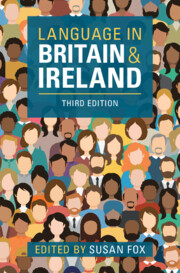Book contents
- Language in Britain and Ireland
- Language in Britain and Ireland
- Copyright page
- Contents
- Figures
- Tables
- Contributors
- Acknowledgements
- Map of Britain and Ireland
- Introduction
- Part I English
- 1 The History of English
- 2 Standard and Non-standard English
- 3 Phonetic and Phonological Variation in England
- 4 Grammatical Variation in England
- 5 Discourse-Pragmatic Variation in England
- 6 Scots and Scottish Standard English
- 7 English in Ireland
- 8 English in Wales
- 9 Insular Varieties of English in Britain
- 9 Insular Varieties of English in Britain
- 9 Insular Varieties of English in Britain
- 9 Insular Varieties of English in Britain
- Part II Multilingualism in Britain and Ireland: The Celtic Languages
- Part III Multilingualism in Britain and Ireland: Minority Languages
- Part IV Multilingualism: The Development of Urban Contact Varieties
- Part V Applied Sociolinguistic Issues
- Index
- References
8 - English in Wales
from Part I - English
Published online by Cambridge University Press: 17 October 2024
- Language in Britain and Ireland
- Language in Britain and Ireland
- Copyright page
- Contents
- Figures
- Tables
- Contributors
- Acknowledgements
- Map of Britain and Ireland
- Introduction
- Part I English
- 1 The History of English
- 2 Standard and Non-standard English
- 3 Phonetic and Phonological Variation in England
- 4 Grammatical Variation in England
- 5 Discourse-Pragmatic Variation in England
- 6 Scots and Scottish Standard English
- 7 English in Ireland
- 8 English in Wales
- 9 Insular Varieties of English in Britain
- 9 Insular Varieties of English in Britain
- 9 Insular Varieties of English in Britain
- 9 Insular Varieties of English in Britain
- Part II Multilingualism in Britain and Ireland: The Celtic Languages
- Part III Multilingualism in Britain and Ireland: Minority Languages
- Part IV Multilingualism: The Development of Urban Contact Varieties
- Part V Applied Sociolinguistic Issues
- Index
- References
Summary
This chapter presents on overview of present-day Welsh English(es) with a focus on regional variation and diachronic developments over the past fifty years. The Anglicisation of Wales has progressed in several phases over the centuries, which is why the accents and dialects of English in Wales are regionally distinctive, the Welsh language and neighbouring English English dialects impacting them to different degrees. The chapter takes the Survey of Anglo-Welsh dialects (Parry 1999) as a starting point and uses corpus and survey data compiled in the twenty-first century as well as recent research publications, thereby examining the main trends of development in the different domains of English. Phonological variation and change are described across a broad North–South continuum, whereas in morphosyntax the greatest differences can be found between the predominantly English-speaking Southeast and the bilingual, historically Welsh-dominant North and West Wales. In regional lexicon, sociolinguistically and nationally salient items are relatively few, originating from both Welsh and English. Finally, the chapter draws attention to recent research, and highlights some caveats and future directions for the study of English in Wales.
Keywords
- Type
- Chapter
- Information
- Language in Britain and Ireland , pp. 208 - 228Publisher: Cambridge University PressPrint publication year: 2024

